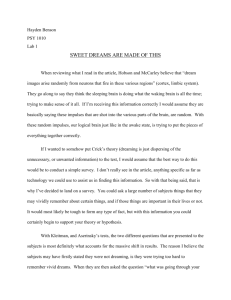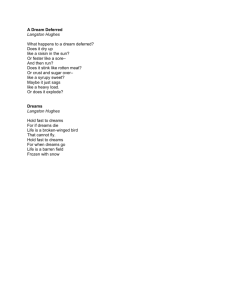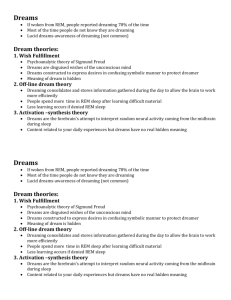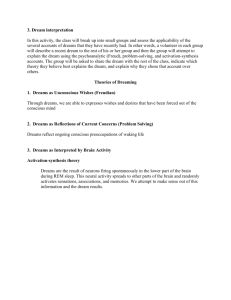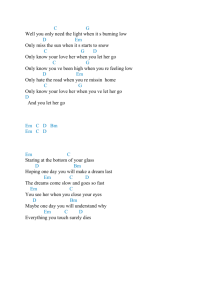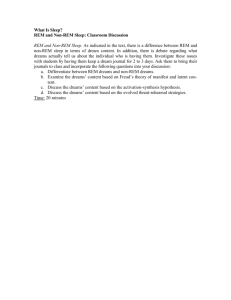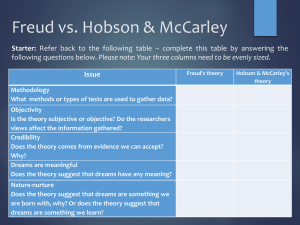dreamsaremadeof
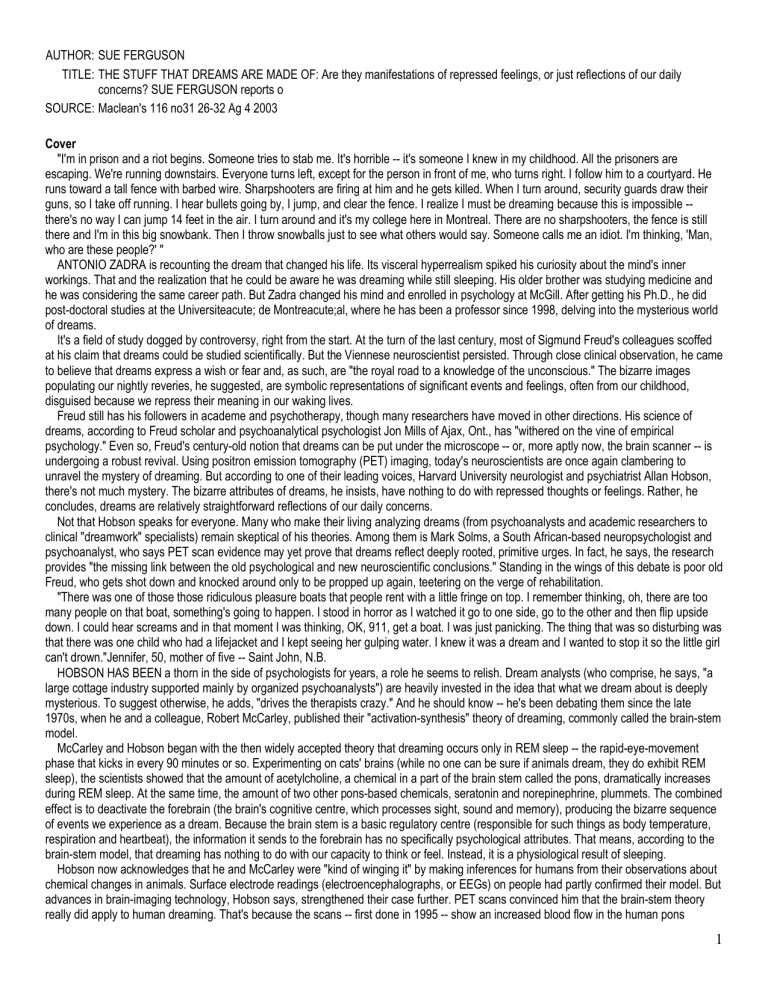
AUTHOR: SUE FERGUSON
TITLE: THE STUFF THAT DREAMS ARE MADE OF: Are they manifestations of repressed feelings, or just reflections of our daily concerns? SUE FERGUSON reports o
SOURCE: Maclean's 116 no31 26-32 Ag 4 2003
Cover
"I'm in prison and a riot begins. Someone tries to stab me. It's horrible -- it's someone I knew in my childhood. All the prisoners are escaping. We're running downstairs. Everyone turns left, except for the person in front of me, who turns right. I follow him to a courtyard. He runs toward a tall fence with barbed wire. Sharpshooters are firing at him and he gets killed. When I turn around, security guards draw their guns, so I take off running. I hear bullets going by, I jump, and clear the fence. I realize I must be dreaming because this is impossible -- there's no way I can jump 14 feet in the air. I turn around and it's my college here in Montreal. There are no sharpshooters, the fence is still there and I'm in this big snowbank. Then I throw snowballs just to see what others would say. Someone calls me an idiot. I'm thinking, 'Man, who are these people?' "
ANTONIO ZADRA is recounting the dream that changed his life. Its visceral hyperrealism spiked his curiosity about the mind's inner workings. That and the realization that he could be aware he was dreaming while still sleeping. His older brother was studying medicine and he was considering the same career path. But Zadra changed his mind and enrolled in psychology at McGill. After getting his Ph.D., he did post-doctoral studies at the Universiteacute; de Montreacute;al, where he has been a professor since 1998, delving into the mysterious world of dreams.
It's a field of study dogged by controversy, right from the start. At the turn of the last century, most of Sigmund Freud's colleagues scoffed at his claim that dreams could be studied scientifically. But the Viennese neuroscientist persisted. Through close clinical observation, he came to believe that dreams express a wish or fear and, as such, are "the royal road to a knowledge of the unconscious." The bizarre images populating our nightly reveries, he suggested, are symbolic representations of significant events and feelings, often from our childhood, disguised because we repress their meaning in our waking lives.
Freud still has his followers in academe and psychotherapy, though many researchers have moved in other directions. His science of dreams, according to Freud scholar and psychoanalytical psychologist Jon Mills of Ajax, Ont., has "withered on the vine of empirical psychology." Even so, Freud's century-old notion that dreams can be put under the microscope -- or, more aptly now, the brain scanner -- is undergoing a robust revival. Using positron emission tomography (PET) imaging, today's neuroscientists are once again clambering to unravel the mystery of dreaming. But according to one of their leading voices, Harvard University neurologist and psychiatrist Allan Hobson, there's not much mystery. The bizarre attributes of dreams, he insists, have nothing to do with repressed thoughts or feelings. Rather, he concludes, dreams are relatively straightforward reflections of our daily concerns.
Not that Hobson speaks for everyone. Many who make their living analyzing dreams (from psychoanalysts and academic researchers to clinical "dreamwork" specialists) remain skeptical of his theories. Among them is Mark Solms, a South African-based neuropsychologist and psychoanalyst, who says PET scan evidence may yet prove that dreams reflect deeply rooted, primitive urges. In fact, he says, the research provides "the missing link between the old psychological and new neuroscientific conclusions." Standing in the wings of this debate is poor old
Freud, who gets shot down and knocked around only to be propped up again, teetering on the verge of rehabilitation.
"There was one of those those ridiculous pleasure boats that people rent with a little fringe on top. I remember thinking, oh, there are too many people on that boat, something's going to happen. I stood in horror as I watched it go to one side, go to the other and then flip upside down. I could hear screams and in that moment I was thinking, OK, 911, get a boat. I was just panicking. The thing that was so disturbing was that there was one child who had a lifejacket and I kept seeing her gulping water. I knew it was a dream and I wanted to stop it so the little girl can't drown."Jennifer, 50, mother of five -- Saint John, N.B.
HOBSON HAS BEEN a thorn in the side of psychologists for years, a role he seems to relish. Dream analysts (who comprise, he says, "a large cottage industry supported mainly by organized psychoanalysts") are heavily invested in the idea that what we dream about is deeply mysterious. To suggest otherwise, he adds, "drives the therapists crazy." And he should know -- he's been debating them since the late
1970s, when he and a colleague, Robert McCarley, published their "activation-synthesis" theory of dreaming, commonly called the brain-stem model.
McCarley and Hobson began with the then widely accepted theory that dreaming occurs only in REM sleep -- the rapid-eye-movement phase that kicks in every 90 minutes or so. Experimenting on cats' brains (while no one can be sure if animals dream, they do exhibit REM sleep), the scientists showed that the amount of acetylcholine, a chemical in a part of the brain stem called the pons, dramatically increases during REM sleep. At the same time, the amount of two other pons-based chemicals, seratonin and norepinephrine, plummets. The combined effect is to deactivate the forebrain (the brain's cognitive centre, which processes sight, sound and memory), producing the bizarre sequence of events we experience as a dream. Because the brain stem is a basic regulatory centre (responsible for such things as body temperature, respiration and heartbeat), the information it sends to the forebrain has no specifically psychological attributes. That means, according to the brain-stem model, that dreaming has nothing to do with our capacity to think or feel. Instead, it is a physiological result of sleeping.
Hobson now acknowledges that he and McCarley were "kind of winging it" by making inferences for humans from their observations about chemical changes in animals. Surface electrode readings (electroencephalographs, or EEGs) on people had partly confirmed their model. But advances in brain-imaging technology, Hobson says, strengthened their case further. PET scans convinced him that the brain-stem theory really did apply to human dreaming. That's because the scans -- first done in 1995 -- show an increased blood flow in the human pons
1
(corresponding with the increased chemical activity they had identified in cats' brains) during REM sleep. They also show that selective areas of the limbic system (concerned with emotion and motivation) are activated, which helps to explain, Hobson says, the heightened feelings and vivid visual imagery of dreams. Similarly, reduced stimulation in areas of the forebrain account for enfeebled attention span, logic, memory and self-awareness when we dream. In other words, the changes that PET scans track in the human brain, says Hobson, support his theory that dreams are simply physiological responses to certain chemical changes set in motion by REM sleep.
Hobson offers a theory of dreaming, not of dreams. His focus is on what dreams have in common rather than their content because, he says, that's all science can reasonably be expected to explain. Still, he believes this approach demystifies dreams. If the exotic features of dreaming are simply by-products of a certain state of brain activation -- and not, as Freud would have it, symbolic representations of repressed urges -- you don't need elaborate interpretations, Hobson says. But no one should use his work to say, "Oh, dreams are a lot of nonsense," he cautions, because they still may tell us something about our emotional preoccupations.
That and much more, say dream analysts, who believe there's much to gain from examining our nightly excursions into an alternative reality. What's more, they say, no one should underestimate the extent to which dreams can contribute to our sense of well-being. According to Fredericton psychologist Alice Finnamore, dreams are full of symbols whose significance isn't always easy to discern. "Looking at a dream dictionary might give you some ideas," she says, "but it's not going to tell you necessarily what your dream means." That's because the symbols are culturally bound and, more importantly, reflect highly personal experiences. Free-association -- letting your mind relax and wander -- is a proven way of figuring out what your dreams mean, she adds.
To help dreamers along, Finnamore runs workshops using a technique developed by American dream guru and author Robert Moss. She asks participants a series of questions designed to prompt connections between their dreaming and waking lives. Her clients, she says, are
"almost always able to find something, even a healing, within their dreams." Nightmares included. "When someone is chasing you in a dream," Finnamore says, "we often think that's something horrible. But it can mean that person has something that can help us."
"I'm being chased by an evil being in the shape of a man. He hates me and will relish killing me. The man is getting close enough that I can see the colour of his clothes. I can hear him breathing and my lungs are bursting with the effort. Then I'm lying in my bed and the man is at the side of it about to crawl over. I can see his features clearly and, though human, he is a monster with one eye lower than the other and hideous wrinkles surrounding his eyes and his mouth. Lips, wet and shiny, pointed rotting teeth loom over my face as he's about to kill me.
Then I'm running and screaming." Andrea, 45, dance teacher -- Edmonton
DREAMS, IN FACT may help us cope with daily pressures. University of Ottawa psychologist Joseph De Koninck has spent 30 years studying the relationship between dreaming and stress. Five out of every seven dreams, he says, are unpleasant -- suggesting that dreaming may be tied up with our processing of stressful situations. When he and his researchers studied people wearing inverting lenses -- which show the world upside down -- for four-day periods, they found that those who began to dream upside down tended to cope better with their waking-life inversion.
As for nightmares and recurring dreams, Montreal's Zadra says they can indicate difficulty dealing with problems. Nightmares are a common symptom among people who suffer from post-traumatic stress disorder, he says, and "people who have recurring dreams tend to score lower on measures of psychological well-being than non-recurrent dreamers" -- a situation that disappears when the recurring dream ceases. But De Koninck stops short of suggesting our dreams cause our stress levels to go up or down. "It's a correlation" he says. "We're still not very advanced in understanding what mechanisms produce dreams." It's possible we have bad dreams, he adds, because our minds are "ventilating, cleaning up bad things" they may have difficulty dealing with when awake.
So where does this wide range of interpretation leave the father of psychoanalysis? Jon Mills's image of a "withering" Freud does seem apt. Zadra accepts that Freud's work has had a huge impact, and that "much of what he said was important." But, he insists, "there is very little, or no, empirical evidence for many of the ideas he put forth." De Koninck says flatly that Freud's main thesis -- that dreams represent repressed wishes or fears -- cannot be substantiated. "It's a religion now," he says. "It's not based on scientific facts."
"I dreamt about a friend of mine, who's a GP, and his wife. They're probably one of the happier couples we know and they're in retirement right now. In my dream, she found out she had cancer and rushed right home and beat up her husband. Went after him with everything she could find: kitchen knives, baseball bats. That's when I woke up. It was brutal." Chas, 55, apple farmer -- Saint John, N.B.
FREUD'S DEFENDERS hail from a different camp. Norman Doidge, head of long-term psychoanalytic psychotherapy for the University of
Toronto's psychotherapy program, points out that Freud is the most cited intellectual of the 20th century -- a distinction bound to lead to any number of erroneous claims made on his behalf. One misconception frequently attributed to Freud is that people -- and our dreams -- are motivated solely by sexual desire. Freud did claim sex is deeply significant, and he had a broad understanding of sexuality as something that begins long before puberty. But to say that, for Freud, it all boils down to sex, "is a gross oversimplification of a very complicated model," says
Doidge. "It wouldn't make the first cut of the Idiot's Guide to Freud."
Mills agrees. He notes that Freud followed his classic 1900 treatise, The Interpretation of Dreams, with 40 more years of research and writing. "Early in his work," says Mills, "Freud very much believed that dreams are the disguised, distorted fulfillment of unconscious wishes, some being primordial urges or impulses, such as sexuality." But by the end of his career, he amended those views, postulating a role for aggression, unconscious guilt and anxiety.
And Freud's credentials as a scientist? He was a "hard-core neuroscience researcher," says Doidge. "He knew an incredible amount" about the way the brain works. Doidge offers a compelling example. When we are awake, our forebrains process visual information in three stages: the primary visual cortex registers things like lines, colour and movement, which are then visually dramatized in a secondary association area; a third area relates those images to an idea, or abstract thought. Freud hypothesized, says Doidge, that "the dreaming mind regresses." In other words, when we dream, that process is reversed: an abstract idea generates an image. "If the idea is something like, 'I'm
2
special, I don't have to go by the rules the way everyone else does,' " explains Doidge, "you might have a dream of being able to walk on water or fly through the air."
It's now pretty clear that Freud had that part right. What's more, research carried out by Mark Solms has proved as much -- leading that neuroscientist to radically challenge Hobson's and McCarley's brain-stem theory of dreaming. In the mid-1980s, Solms began interviewing patients with damage to certain areas of their forebrain. In waking life, a damaged primary visual cortex causes blindness; a damaged secondary association area causes complex perceptual disorders; while lesions in the third area have no direct effect on perception.
But in dreaming, Solms discovered, that pattern is reversed. Patients with damage to the third area experience a total loss of dreaming, while those with lesions in the secondary association area report complex dream image disorders (such as an absence of colour or people without recognizable faces). Lesions in the primary visual cortex have no effect on dreaming. In other words, says Solms, when we dream, our brains do process information in the opposite direction, just as Freud hypothesized.
Interviews with some of Solms's other subjects, however, revealed something truly unexpected. Nine of the 365 people in his study had suffered damage to what's called the ventromesial frontal quadrant of their brains, which includes the white fibres located just behind the eyes. All nine reported a total and permanent loss of dreaming. But their REM sleep continued, leaving Solms to postulate that REM sleep and dreaming are distinct phenomena -- sometimes associated, sometimes not. As well, the fact that dreaming ceased in sleepers with frontal lobe damage despite normal functioning of the brain stem led Solms to conclude, contrary to Hobson and McCarley, that dreams must originate in the frontal lobe, the highest, quintessentially human, part of the forebrain.
Nine cases, however, could hardly be considered authoritative, and Solms began searching for a way to corroborate his theory. Then he recalled that fibres in the ventromesial frontal quadrant had been deliberately severed in thousands of people who underwent prefrontal leucotomies (the successor operation to the infamous frontal lobotomy) in the 1950s and 1960s to treat severe psychotic illnesses. A tour through reports from that period confirmed his suspicion: those patients had stopped dreaming, too. And while Solms's theory grew out of his work with brain-lesioned patients in the 1980s, today's PET scans, he says, confirm it: "The structures that scans show as activated during dreaming sleep are the same structures that, when damaged, as my research showed, lead to abnormal dreams or a total loss of dreaming."
"I dreamt that I was in an alley in Edmonton that I used to walk down when I was a child. I was with a woman I didn't recognize but it felt as though I knew her quite well. As we were walking a large green wall of clover about 12 feet high began to form and block our way. It was moving slowly toward us and had abnormally large leaves that were pulsing in a surreal state, becoming larger and smaller. I said we should try and find a four-leaf one, but then I became aware how bizarre the situation was and woke myself up."Joe, 40, actor -- Vancouver
THE POSSIBILITY that dreams originate in the ventromesial quadrant is good news for Freud backers. Because that is part of the forebrain, Solms concludes, it follows that dreams do have something to do with our mental capacities, our feelings and thoughts. What's more, that area of the forebrain connects the limbic system with the higher frontal areas, making it an essential part of our motivational system. It is, he says, "what makes us turn to the world to look for the thing that we need." Think of a dog foraging for a bone, he adds,
"wagging its tail, twitching its whiskers." Such a basic need-driven function corresponds nicely with the Freudian claim that dreams represent our unconscious wishes or urges. Solms is careful to say his work doesn't prove Freud was right. But, he adds, "it's strikingly consistent with the sort of thing Freud was claiming on the basis of an entirely different type of approach."
Peering into the brain, then, has reignited a century-old debate. And, once again, neurologists are redefining its terms, albeit by relying on more hard-core scientific methods than Freud's. Solms credits Hobson and McCarley with discovering the mechanism for REM sleep, but believes their dream theory relies too heavily on those mechanisms. While REM sleep, he notes, is "the most likely and most sustained trigger for dreams during sleep," it's not the only trigger. "If you want to understand what a dream is," Solms says, "you want to look at the mechanisms in the forebrain, not at what it is that sets them working, especially since the thing that sets them working is neither necessary nor sufficient." Hobson's claim that specific forebrain structures are activated in response to chemicals firing up from the pons, Solms adds, cannot account for other neuroscientific research that shows people with damage to the pons still report dreams.
Hobson bristles at such criticism. "I have a theory of mental brain state -- not just REM sleep -- and one of the mental states is dreaming."
He accepts that, "to some extent, dreams are driven from the top down," but insists that the pons chemicals are what put the forebrain "in the mood to dream" in the first place. "Can you do this without the brain stem? I think not." Pointing out that Solms is a psychoanalyst who, in his view, has a vested interest in proving Freud's wish-fulfillment theory, he adds, "Freud is a historical relic. Solms hasn't quite realized that."
Clearly, a glimpse at brain activity is one thing. Reaching a definitive interpretation of that activity is another -- as elusive, perhaps, as interpreting a dream.
3

